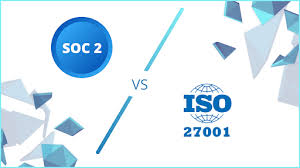
In today's data-driven world, security compliance has become a key concern for businesses across all industries. Two of the most respected frameworks for information security are SOC 2 (Service Organization Control 2) and ISO 27001. While both offer robust guidelines for managing sensitive data, they come with varying costs and benefits. For organizations looking to enhance their security posture, understanding these factors is critical in making an informed decision.
Section 1: Overview of SOC 2 and ISO 27001
SOC 2 is primarily used by service providers to demonstrate the security of the systems they use to process customer data. It focuses on five trust service criteria: security, availability, processing integrity, confidentiality, and privacy. SOC 2 audits are generally required by customers, especially in industries where data security is a significant concern.
ISO 27001 is an internationally recognized standard for information security management systems (ISMS). It provides a framework for managing sensitive company and customer data, and involves continual risk assessments to ensure compliance. While ISO 27001 certification is more globally recognized, achieving and maintaining it requires substantial effort and documentation.
Section 2: Costs of SOC 2 and ISO 27001 Compliance
While both SOC 2 and ISO 27001 offer high levels of data protection, their associated costs differ. Here are key cost considerations for each:
- Implementation Costs: Implementing SOC 2 or ISO 27001 requires significant time and resources. For SOC 2, companies must design security controls based on the five trust service principles, which might involve purchasing new technology or hiring consultants. Similarly, ISO 27001 implementation involves creating a comprehensive ISMS, which can include staff training, risk management tools, and ongoing monitoring systems. Both frameworks require dedicated personnel or external auditors to ensure compliance. The cost of initial setup can range from $50,000 to over $100,000, depending on company size and complexity.
- Audit Costs: SOC 2 audits must be conducted annually by third-party auditors. These audits can cost between $20,000 and $50,000 per year. ISO 27001 certification audits also require a third-party assessor and generally occur every three years. The cost of ISO 27001 certification audits typically ranges from $10,000 to $30,000, with additional surveillance audits conducted annually to maintain certification. Organizations must also factor in the costs of addressing any non-conformities found during the audit process.
- Operational Costs: Maintaining compliance with SOC 2 or ISO 27001 involves ongoing operational costs. SOC 2 requires continuous monitoring and reporting on security controls, while ISO 27001 necessitates regular risk assessments and updates to the ISMS. These activities often require additional staffing or outsourcing to managed service providers. The annual cost of maintaining compliance can vary, but larger organizations can expect to spend up to $100,000 per year on compliance-related activities.
Section 3: Benefits of SOC 2 and ISO 27001 Compliance
Despite the upfront and ongoing costs, the benefits of SOC 2 and ISO 27001 compliance are substantial:
- Enhanced Security Posture: Both SOC 2 and ISO 27001 ensure that organizations implement stringent security measures, reducing the likelihood of data breaches and other cybersecurity incidents. By adhering to these standards, companies can build trust with customers, demonstrating their commitment to protecting sensitive information.
- Competitive Advantage: SOC 2 and ISO 27001 certifications are often viewed as a differentiator in the market, especially for businesses handling sensitive data. Organizations that achieve compliance can use these certifications to attract new customers and reassure existing ones. For cloud service providers and SaaS companies, being SOC 2 compliant is often a minimum requirement for enterprise clients.
- Regulatory Compliance: Many industries are subject to strict regulations on data protection and privacy. SOC 2 and ISO 27001 compliance can help organizations meet legal and regulatory requirements such as GDPR, HIPAA, and CCPA. This can prevent costly fines and penalties associated with non-compliance.
- Improved Processes and Risk Management: Both standards require organizations to establish systematic approaches to managing risks. This leads to more efficient operations, reduced risk of security breaches, and clearer accountability across the organization. Companies often find that pursuing SOC 2 or ISO 27001 compliance forces them to improve other business processes, leading to operational benefits beyond security.
Section 4: Conclusion
Achieving SOC 2 or ISO 27001 compliance requires significant investment in both time and resources. However, the benefits far outweigh the costs for organizations serious about securing customer data and building trust in today’s digital landscape. Whether a company chooses SOC 2 for its U.S.-centric focus or ISO 27001 for its global recognition, the result is an enhanced security posture, competitive differentiation, and stronger risk management.
Organizations must carefully weigh the costs and benefits of each compliance framework, but in many cases, the long-term advantages—particularly in avoiding security breaches and meeting regulatory requirements—make the investment worthwhile.
